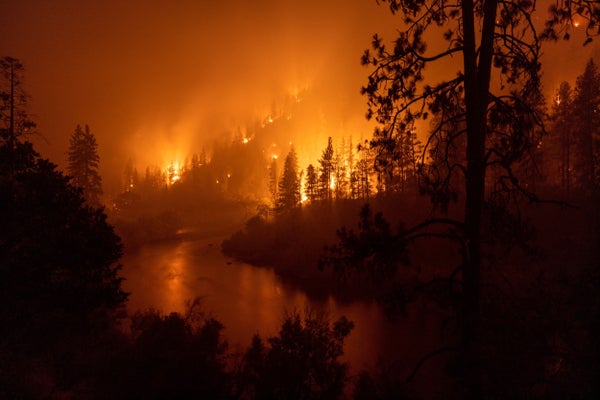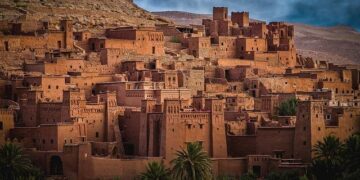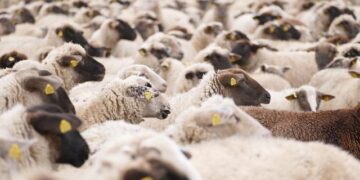Wildfires Used to Die Down after Dark. Drought Has Changed That
About 20 percent of large wildfires in North America now burn overnight because of drought conditions, straining firefighting resources
By Chelsea Harvey & E&E News

Flames burn to the Klamath River during the McKinney Fire in the Klamath National Forest northwest of Yreka, California, on July 31, 2022.
Credit:
David MCNew/AFP via Getty Images
CLIMATEWIRE | Night was once a time of reprieve during wildfire season, when the cool air and moist ground would temporarily slow the spread of angry blazes.
But that’s changing as the climate warms.
Recent studies have found that nighttime burning is growing more intense across the globe, including in North America, where the annual wildfire season has already been worsening for decades. Researchers have found that rising temperatures and increases in the drying power of the nighttime air may be playing a role in a switch to 24-hour blazes that has long worried fire managers.
On supporting science journalism
If you’re enjoying this article, consider supporting our award-winning journalism by subscribing. By purchasing a subscription you are helping to ensure the future of impactful stories about the discoveries and ideas shaping our world today.
Now a new paper, published Wednesday in the scientific journal Nature, suggests that drought is largely to blame.
Researchers from the University of Alberta analyzed the daily burning cycles of more than 23,000 fires across North America between 2017 and 2020, identifying a total of 1,095 blazes that burned straight through to the next morning. They found that biggest driver for those overnight burning events were the abundance and dryness of the vegetation on the landscape — factors closely tied to drought conditions.
That was a bit of a surprise, said lead study author Kaiwei Luo, a researcher at the University of Alberta. Luo and his co-authors expected heat to be a larger factor, especially since research suggests that temperatures are rising faster at night than during the day.
But drought has become a powerful influence in western North America in recent decades, and it’s growing worse as temperatures rise. The southwestern U.S. is currently in the grip of a decadeslong “megadrought,” scientists say, with one recent study finding that the period between 2000 and 2021 was the region’s driest 22-year span in the last 1,200 years.
These conditions are helping erode a “natural barrier” to wildfire spread, Luo said.
“The temperatures will drop down at night and the relative humidity will increase — that will slow down the fast spread,” he said. “But things change.”
Drought isn’t the only factor in overnight blazes. The study also notes that fire weather conditions have been increasing across North America for decades, with changes in temperature, winds, precipitation and other weather-related metrics that make wildfires more likely to spread.
Researchers found that overnight burning is still rare for small fires, which accounted for most of the blazes analyzed. But about 20 percent of large wildfires — or those burning more than 1,000 hectares, or 3.86 square miles — featured an overnight burning event. That proportion climbed as high as 35 percent in mountainous regions of the West.
Overnight burning events were associated with significantly hotter, drier and windier conditions than fires with no nighttime burning, the study found. They also tended to occur shortly after ignition and often burned for multiple nights in a row. The top 10 most extreme cases averaged about 27 nights of overnight burning.
A growing challenge for fire managers
Worsening overnight burning has concerned fire managers for years, said Neal McLoughlin, superintendent of predictive services for the British Columbia Wildfire Service.
“I’ve been in fire for 20 years, and when I started my career, it was a very rare phenomenon,” he said. “Now — particularly in the last several busy fire seasons, particularly in the province of British Columbia — it’s been something that happens on most fires. Maybe not every day, but it’s a common occurrence to see overnight burning.”
These overnight burns can put a major strain on firefighting resources, he added. On-the-ground work is far more dangerous in the dark of night. And aircraft use is often restricted to daylight hours, as pilots must follow strict rules on the number of hours they can fly.
“When you start shifting from fighting fire for the 12 hours of daylight, and moving into a 24-hour emergency response, you almost need two sets of wildfire crews, and you need two sets of pilots and aircraft — one that can work during the day and maybe a nighttime shift,” McLoughlin said. “When resources are scarce — and they certainly have been over recent seasons — that can be a barrier.”
Recent years have seen a major strain on firefighting resources in western North America. British Columbia experienced its most destructive wildfire season on record in 2023, with the Donnie Creek wildfire becoming the largest in the province’s history. Meanwhile, eight of California’s top 10 largest wildfires have occurred in the last decade, according to the California Department of Forestry and Fire Protection.
Worsening overnight burns is an added stress on an already overburdened firefighting system. So it’s important for fire managers to work with researchers on developing ways to better predict and prepare for nighttime fires, experts say.
Understanding the long-term changes in overnight burns “can help fire managers devise different mitigation and response strategies than what may have been implemented historically, when typically increased nighttime humidity and lower temperatures favored decreased fire activity,” said Lisa Bryant, a spokesperson for the U.S. Forest Service Rocky Mountain Research Station, in an email to E&E News.
Many of today’s management tools focus on daily predictions of fire danger levels, McLoughlin noted. Developing tools that can make more granular predictions throughout the day, hour by hour, could help fire managers better plan their attacks, schedule their crews and issue warnings to nearby communities.
Improving these kinds of forecasts may be possible, researchers say. The new study suggests that overnight fires are relatively predictable. The researchers found that daytime conditions largely set the stage for nighttime burns, and they were able to accurately predict about two-thirds of the overnight burns in their data set using a mathematical model.
“Everything we do right now is structured to that daytime period,” McLoughlin said. “We really need to be speaking to the other half of the day, where our tools are not providing any insight. That would be the direction I would like to see our predictive tools go.”
Reprinted from E&E News with permission from POLITICO, LLC. Copyright 2024. E&E News provides essential news for energy and environment professionals.
>>> Read full article>>>
Copyright for syndicated content belongs to the linked Source : Scientific American – https://www.scientificamerican.com/article/wildfires-used-to-die-down-after-dark-drought-has-changed-that/



























